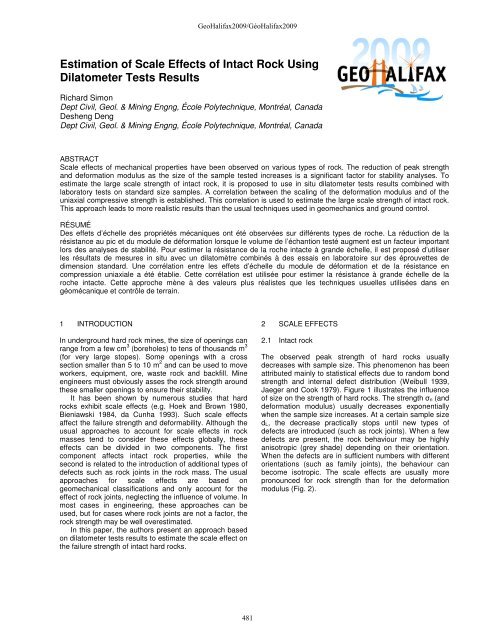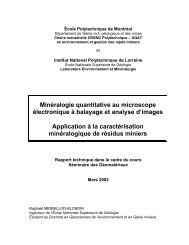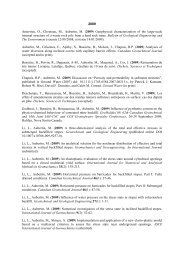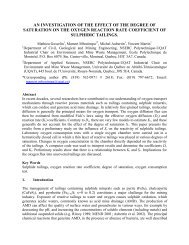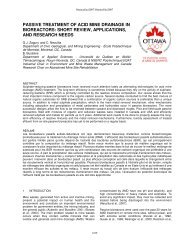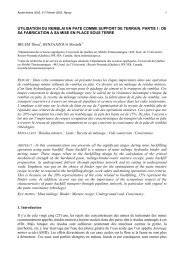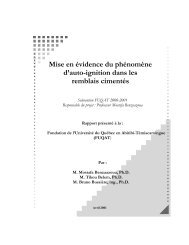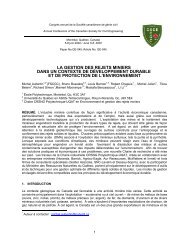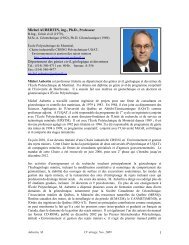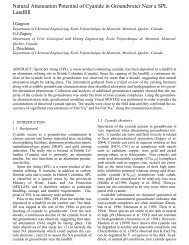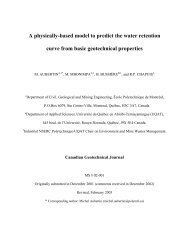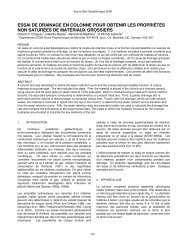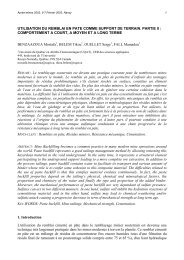Estimation of scale effects of intact rock using dilatometer tests results.
Estimation of scale effects of intact rock using dilatometer tests results.
Estimation of scale effects of intact rock using dilatometer tests results.
Create successful ePaper yourself
Turn your PDF publications into a flip-book with our unique Google optimized e-Paper software.
GeoHalifax2009/GéoHalifax2009The correction for the <strong>rock</strong> mass strength is given by acontinuity parameter Γ (Aubertin et al. 2000, 2001):σ cm = Γ σ c [1]p⎡ ⎛ π RMR ⎞⎤Γ = Γ100⎢0.5⎜1− cos ⎟⎥ ⎣ ⎝ 100 ⎠ ⎦[2]withσΓcL100 =σc[3]Here, σ cm is the <strong>rock</strong> mass uniaxial compressive strength,σ cL is the <strong>intact</strong> <strong>rock</strong> large <strong>scale</strong> uniaxial compressivestrength, σ c is the <strong>intact</strong> <strong>rock</strong> uniaxial compressive on astandard diameter sample (i.e. 50 mm), RMR is the value<strong>of</strong> the geomechanical classification (Bieniawski 1989), pis a material parameter that varies between 2 and 3 andΓ 100 is the value <strong>of</strong> the continuity parameter for a RMRvalue <strong>of</strong> 100 (i.e. without <strong>rock</strong> joint). Figure 4 shows thecomparison between the Hoek-Brown and the Aubertin etal approaches. It can be seen that these approaches aresimilar up to a RMR value <strong>of</strong> about 70. For RMR > 70, theAubertin et al approach tends to a maximum value Γ 100defined by Eq. 3. However, the value <strong>of</strong> the large <strong>scale</strong>strength σ cL cannot be easily obtained from typical siteinvestigation. This value can either be obtained bylaboratory testing different sample sizes, which can bevery expensive and time consuming, or can be estimatedby other means.3 INDIRECT EVALUATION OF THE LARGE SCALESTRENGTH OF INTACT ROCKSIt has been observed in several studies (e.g. Jackson andLau 1990, Tsoutrelis and Exadaktylos 1993, Singh et al.1997) that there is a correlation between the <strong>scale</strong> effecton the deformation modulus and the uniaxial peakstrength. To try to evaluate this correlation betweenstrength and deformation modulus, a field and laboratorystudy has been carried out. Boreholes with different sizeshave been drilled at the CANMET underground mine inVal-d’Or (Quebec). Boreholes 6 to 8 m long, ranging fromsize AQ, BQ, NQ and HQ, have been drilled in parallel atthree different levels (40, 70 and 130 m). In situ<strong>dilatometer</strong> <strong>tests</strong> have been performed in the NQ holes byLabrie et al. (2006). The different <strong>rock</strong> core samplescollected from the diamond drilling have then been testedin uniaxial compression with strain measurements at theÉcole Polytechnique <strong>rock</strong> mechanics Laboratory. The<strong>results</strong> presented in this paper come from the 130 m <strong>tests</strong>ite (shown in Figure 5) but the three sites showed similartrends (Simon 2008).3.1 Laboratory <strong>tests</strong>For each size holes, ten samples were collected andtested in uniaxial compression with strain measurements.The different core sample diameters were respectivelyafter preparation 30, 36, 48 and 63 mm. These <strong>tests</strong> havebeen conducted in conformity with ASTM standard.Figure 6 shows the <strong>results</strong> <strong>of</strong> the mean uniaxialcompressive strength as a function the sample diameter(with the standard deviation range). It shows a reduction<strong>of</strong> the mean strength as the diameter <strong>of</strong> the sample with avery good correlation with a negative power law. Figure 7shows the variation <strong>of</strong> the mean deformation modulus(taken as the tangent slope at 50% <strong>of</strong> the peak strength)as a function on the sample diameter. Here again, adecrease in the value <strong>of</strong> the modulus as the diameterincreases is observed. Figure 8 shows the <strong>scale</strong> effect forthe mean uniaxial compressive strength and meandeformation modulus normalized by the value <strong>of</strong> thestandard diameter <strong>of</strong> 50 mm (actually, 48 mm). It can beseen that the <strong>scale</strong> effect is more pronounced for thepeak strength than for the deformation modulus.Figure 4. Comparison between the Hoek-Brown (1988)and the Aubertin et al. (2000) approach to estimate <strong>rock</strong>mass strength.Figure 5. Test site for the 130 m level diamond drillboreholes (after Labrie et al. 2006).3.2 In situ <strong>dilatometer</strong> <strong>tests</strong>Dilatometer <strong>tests</strong> have been performed at the threedifferent locations by Labrie et al. (2006). The <strong>dilatometer</strong>used is a ROCTEST, Probex-1 model. The <strong>dilatometer</strong>483
GeoHalifax2009/GéoHalifax2009test performed inside drill holes consist in applying acontinuous and constant pressure on the borehole wallsand measuring the resulting deformation. The pressure isapplied through a hydraulic radially expandable cylindricalprobe that fit in N size boreholes. Five or six differentpressure levels are enough to plot the curve <strong>of</strong> thepressure vs injected fluid volume. The deformationmodulus can then be determined. Labrie et al. (2006)performed 14 <strong>dilatometer</strong> <strong>tests</strong> in the NQ (A & B)boreholes <strong>of</strong> the 130 m level site (Fig. 5). The meandeformation modulus obtained with the <strong>dilatometer</strong> <strong>tests</strong>is 28 GPa, comparatively with the mean value <strong>of</strong> 73 GPaobtained in laboratory <strong>tests</strong> performed on the core fromthese holes. This somehow proves that the volumeinvolved in this test is much larger than that <strong>of</strong> thelaboratory <strong>tests</strong>. It is also interesting to note that thevalues obtained with the <strong>dilatometer</strong> <strong>tests</strong> are lower thanthose obtained from most empirical equations proposedin the literature and shown in Table 1 (see Simon 2008for more details).Figure 6. Mean uniaxial compressive strength as afunction <strong>of</strong> the sample diameter for the 130 m level.Figure 8. Variation <strong>of</strong> the mean uniaxial compressivestrength and <strong>of</strong> the mean deformation modulusnormalized by the mean value <strong>of</strong> the standard size (50mm) as a function <strong>of</strong> the sample diameter for the 130 mlevel.To estimate the volume implied in the <strong>dilatometer</strong> test,a numerical model was built <strong>using</strong> the FLAC s<strong>of</strong>tware(Itasca 2002). Different analyses showed that the volumearound the hole affected by the test is around 141 000cm 3 (Fig. 9) or a equivalent diameter <strong>of</strong> around 2 m.Figure 10 shows the variation <strong>of</strong> the deformationmodulus as a function <strong>of</strong> volume including the <strong>dilatometer</strong>test <strong>results</strong>. It can be seen that the <strong>dilatometer</strong> test<strong>results</strong> does not really follow the trend <strong>of</strong> the laboratory<strong>results</strong> (even though the correlation factor is high). Thiscould be explained by the influence <strong>of</strong> <strong>rock</strong> joints in the<strong>dilatometer</strong> test, which make the <strong>scale</strong> effectdiscontinuous (see Fig. 1). The deformation modulusvalue obtained with the <strong>dilatometer</strong> test cannot beconsidered to be a value <strong>of</strong> <strong>intact</strong> <strong>rock</strong>.4 PROPOSED APPROACH TO ESTIMATE THESCALE EFFECT OF INTACT ROCK4.1 <strong>Estimation</strong> <strong>of</strong> the large <strong>scale</strong> deformation modulusTo be able to use the <strong>results</strong> obtained for the <strong>dilatometer</strong><strong>tests</strong>, a correction must be applied to estimate the value<strong>of</strong> the deformation modulus <strong>of</strong> the <strong>rock</strong> mass withoutjoints, or large <strong>scale</strong> modulus (E L). To obtain the value <strong>of</strong>E L, Eq. 2 can be transformed to:Figure 7. Mean deformation modulus as a function <strong>of</strong> thesample diameter for the 130 m level.EEDL = [4]p⎡ ⎛ π RMR ⎞⎤⎢0.5⎜1− cos ⎟⎥⎣ ⎝ 100 ⎠⎦Where E L is the large <strong>scale</strong> deformation modulus and E Dis the deformation modulus obtained with the <strong>dilatometer</strong>test. Here, it is suggested to use a value <strong>of</strong> 1 for the pexponent. Note that with p = 1, the equation is similarthan that proposed by Mitri et al. (1994). The correctedvalue (or large <strong>scale</strong> modulus) E L obtained for the 130 mlevel is then 31.4 GPa (for a measured RMR value <strong>of</strong>77.5).484
GeoHalifax2009/GéoHalifax2009Job Title: Dilatometer simulationσN= σL+( σ − σ )SLdL− dNdL− dSλ[5]a)Where σ N is the strength <strong>of</strong> a d N diameter sample, σ Sis the small <strong>scale</strong> (d S) strength, σ L is the large <strong>scale</strong> (d L)strength, λ is an exponent that controls the non-linearity<strong>of</strong> the curve and 〈 〉 is given by (〈x〉 = (x + |x|)/2 ≥ 0). Thislast parameter means that if d N > d L, the value <strong>of</strong> 〈 〉 is 0and then σ N = σ L. Figure 11 shows the type <strong>of</strong> curvesobtained from Eq. 5.The study <strong>of</strong> <strong>scale</strong> <strong>effects</strong> <strong>of</strong> Li et al. (2007) hasshown that the small and large <strong>scale</strong> diameter d S and d Lare typically the same for several fine grained <strong>rock</strong> types.The values proposed by Li et al. (2007) are d S = 5 mmand d L = 2000 mm. When there is no value available forthe exponent λ, Li et al. (2007) suggested <strong>using</strong> a value<strong>of</strong> 20.σNλ1 > λ2 > λ3σSσc50λ = λ3λ = λ2λ = λ1b)Figure 9. <strong>Estimation</strong> <strong>of</strong> the volume influenced in the<strong>dilatometer</strong> test. a) Model built <strong>using</strong> the Flac s<strong>of</strong>tware. b)displacements obtained from the simulation.σLd Sd 50d 50d LLog d NFigure 11. Schematic representation <strong>of</strong> the strength <strong>scale</strong>effect given by Eq. 5 where σ c50 is the uniaxialcompressive strength <strong>of</strong> a 50 mm diameter sample (afterLi et al. 2007).To estimate the small <strong>scale</strong> strength σ S, a simplestatistical approach was developed by Li et al. (2007).This approach is based on the hypothesis that for a smallenough probability (that depends <strong>of</strong> the number <strong>of</strong> <strong>tests</strong>performed), a statistical maximum limit would correspondto the small <strong>scale</strong> strength. This estimation can beformulated as follow (Li et al. 2007):tα/ 2, νσcS= σc+ S0n −1[6]Figure 10. Variation <strong>of</strong> the deformation modulus) as afunction <strong>of</strong> the diameter for the 130 m level (<strong>dilatometer</strong>test <strong>results</strong> taken from Labrie et al. 2006).4.2 Scale effect <strong>of</strong> the uniaxial compressive strengthTo define the <strong>scale</strong> effect evolution affecting the uniaxialcompressive strength, Aubertin et al. (2002) haveproposed the following equation:Where σ cS is the small <strong>scale</strong> uniaxial compressivestrength, σcis the mean value <strong>of</strong> the uniaxialcompressive strength <strong>of</strong> standard diameter samples, t α/2,νis the Student law function with a confidence level <strong>of</strong> αand a ν (= n – 1) degree <strong>of</strong> liberty, n is the number <strong>of</strong>samples tested and S 0 is the standard deviation <strong>of</strong> theuniaxial strength measured values. Based on Eq. 6, avalue <strong>of</strong> 211 MPa for σ cS was obtained for the 130 mlevel.485
GeoHalifax2009/GéoHalifax2009To estimate the large <strong>scale</strong> strength σ L, an approachbased on the <strong>dilatometer</strong> test and standard laboratory test<strong>results</strong> is proposed. This approach was developed basedon the <strong>results</strong> obtained for the three sites investigated(Simon 2008). The first step is to plot the curve <strong>of</strong> thecorrected large <strong>scale</strong> deformation modulus (Eq. 4) withthe standard deformation modulus (50 mm diametersample) as shown in Figure 11. A power law curve canthen be determined with the following general format:ELE50mm−m = m21 * d[7]A similar curve can also be established for thestrength:σL−= c1* dC0 (50mm)c 2Based on the <strong>results</strong> obtained for the 3 sites, thefollowing empirical equations are proposed to relate thedeformation modulus and strength size functions:c21 = m 1[9]c 2 = m 2[10]For the 130 m level site, this leads to values <strong>of</strong> 5.7and 0.47 for c 1 and c 2 respectively. The values obtainedwith Eq. 9 & 10 are relatively similar to the ones given bythe strength trend curve in Fig. 11. For a large <strong>scale</strong>diameter <strong>of</strong> 2000 mm, Eq. 8 gives a large <strong>scale</strong> strengthσ L <strong>of</strong> 20.5 MPa.Figure 11. Variation <strong>of</strong> the normalized uniaxialcompressive strength and normalized deformationmodulus for the 130 m level.Figure 12 shows the final <strong>scale</strong> effect curve based onEq. 5. It can be seen that the proposed curve differs fromthe trend curve fitted on the strength data.[8]Figure 12. Variation <strong>of</strong> the uniaxial compressive strength<strong>of</strong> the 130 m level site obtained with Eq. 5. σ S = 211 MPa,d S = 5 mm, σ L = 20.5 MPa, d L = 2000 mm and λ = 23.5 DISCUSSION AND CONCLUSIONSThe laboratory and field <strong>results</strong> obtained in this studyindicate that there is a <strong>scale</strong> effect on both the uniaxialcompressive strength and the deformation modulus asboth properties tend to decrease as size increases. It alsoshows that the large <strong>scale</strong> strength <strong>of</strong> <strong>intact</strong> <strong>rock</strong> can bemuch smaller than the strength <strong>of</strong> standard size samples.Dilatometer test <strong>results</strong> also showed smaller valuesthan the values obtained from empirical equationsproposed in literature. This illustrates how usualapproaches can lead to overestimations by onlyconsidering the effect <strong>of</strong> <strong>rock</strong> joints. The deformationmodulus measured in situ showed values lower by 15%to 170% than the deformation modulus obtained with theempirical equations shown in Table 1 (see Simon 2008for more details). It appears that a two-step approach ismore adequate to take into account <strong>scale</strong> <strong>effects</strong> for the<strong>rock</strong> and <strong>rock</strong> mass.An approach to estimate the large <strong>scale</strong> strength <strong>of</strong><strong>intact</strong> <strong>rock</strong> has been proposed. This approach is based <strong>of</strong><strong>dilatometer</strong> test <strong>results</strong> and laboratory <strong>tests</strong> on standardsize samples. This approach is based on the hypothesisthat there is a link between the <strong>scale</strong> effect on strengthand deformability <strong>of</strong> hard <strong>rock</strong>s. This hypothesis might notbe true for all type <strong>of</strong> <strong>rock</strong>s. It is also assumed here thatthe volume involved with the <strong>dilatometer</strong> test is largeenough to provide a good estimate <strong>of</strong> the large <strong>scale</strong>deformation modulus. The <strong>scale</strong> effect on the modulusobserved in this study indicates that the ratio <strong>of</strong> E d/E 50mmis between 0.37 to 0.43, which is lower than all the ratiosE m/E 50mm obtained with the equations <strong>of</strong> Table 1.The determination <strong>of</strong> the empirical equationsparameters (Eq. 9 & 10) proposed here are based on avery limited number <strong>of</strong> cases. However, the large <strong>scale</strong>strength obtained with this approach are very similar tothe one obtained with a statistical approach proposed byLi et al. (2007; see Simon 2008 for more details).If the popular Hoek and Brown (1988) criteria is usedto estimate the <strong>rock</strong> mass uniaxial compressive strengthσ cm at the 130m level site, a value <strong>of</strong> 38.1 MPa is obtained(for a RMR value <strong>of</strong> 77.5). This value is much larger thanthe large <strong>scale</strong> value <strong>of</strong> 20.5 MPa obtained for <strong>intact</strong> <strong>rock</strong>with the proposed approach. Using Eq. 1-3 leads to a486
GeoHalifax2009/GéoHalifax2009value <strong>of</strong> σ cm between 14 and 16 MPa (depending on thevalue <strong>of</strong> p in Eq. 2). Then, the proposed approach can beconsidered more conservative than the usual approachesfor estimating the <strong>rock</strong> mass strength.The value estimated for d L also has an impact on thelarge <strong>scale</strong> strength with the proposed approach. Thisvalue was estimated by the case studies performed by Liet al. (2007) and by numerical simulation. Figure 13shows how this value influences the estimation <strong>of</strong> σ L. Itcan be seen that a higher value <strong>of</strong> d L reduce the value <strong>of</strong>the large <strong>scale</strong> strength with the proposed approachbased on <strong>dilatometer</strong> test <strong>results</strong>. It could be argued thatit would be more conservative to use a higher value thanthe value used in this study (2000 mm), but more casestudy are needed to evaluate this aspect.The mean reduction <strong>of</strong> strength Γ 100 for the <strong>intact</strong> <strong>rock</strong>estimated in this study with the proposed approach was0.15. This is in concordance with other studies publishedin the literature (e.g. Jahns 1966, Bieniawski 1968, Prattet al. 1972, Herget and Unrug 1974, Singh 1981, Swolfs1983, Natau et al. 1995). More investigations are howeverneeded to validate the proposed approach.Figure 13. Variation <strong>of</strong> the estimated large <strong>scale</strong> strength<strong>of</strong> the 130 m level site depending on the selected value <strong>of</strong>the large <strong>scale</strong> diameter d L.ACKNOWLEDGEMENTSThe authors would like to acknowledge the financialcontributions <strong>of</strong> the Institut Robert-Sauvé en santé et ensécurité du travail (IRSST) and NSERC.REFERENCESAubertin M., Li L. and Simon R. 2000. A multiaxial stresscriterion for short term and long term strength <strong>of</strong>isotropic <strong>rock</strong> media. International Journal <strong>of</strong> RockMechanics and Mining Science. 37, 1169-1193.Aubertin, M., Li, L. and Simon, R. 2001. Evaluating thelarge <strong>scale</strong> strength <strong>of</strong> <strong>rock</strong> mass with the MSDPucriterion. Rock Mechanics in the National Interest:Proc. 38th U.S. Rock Mech. Symp., Elsworth et al.(eds), Balkema, vol.2, 1209-1216.Aubertin, M., Li, L. and Simon, R. 2002. Effet del'endommagement sur la stabilité des excavationssouterraines en roches dures. Rapport final présentéà l'Institut de recherche Robert-Sauvé en santé etsécurité du travail du Québec (IRSST), Projet 98-004.Barton, N. 2002. Some new Q-value correlations to assistin site characterisation and tunnel design. Int. J. RockMech. Min. Sci., 39, 185–216.Bieniawski, Z.T. 1968. The effect <strong>of</strong> specimen size oncom-pressive strength <strong>of</strong> coal. Int. J. Rock Mech. Min.Sci. 5: 325-335.Bieniawski Z.T. 1978. Determining <strong>rock</strong> massdeformability: experience from case histories. Int JRock Mech Min Sci Geomech Abstr; 15 : 237–47.Bieniawski, Z.T. 1984. Rock Mechanics Design in Miningand Tunnelling. A.A. Balkema.Bieniawski ZT. 1989. Engineering <strong>rock</strong> massclassification. New York: Wiley.da Cunha AP. 1993. Research on <strong>scale</strong> <strong>effects</strong> in thedetermination <strong>of</strong> <strong>rock</strong> mass mechanical properties -the Portuguese experience. In: da Cunha AP, editor.Scale <strong>effects</strong> in <strong>rock</strong> masses. Rotterdam: Balkema,285-292.Herget, G. and Unrug, K. 1974. In-situ strength prediction<strong>of</strong> mine pillars based on laboratory <strong>tests</strong>. In Advancesin Rock Mechanics: Proceedings <strong>of</strong> the ThirdCongress <strong>of</strong> the International Society for RockMechanics, 1-7 September 1974, Denver, ColoradoII(A): 150-155. Washington, D.C.: National Academy<strong>of</strong> Sciences.Hoek E and Brown ET 1980. Underground excavations in<strong>rock</strong>. London Institution <strong>of</strong> Min & Metall.Hoek, E. and Brown, E.T. 1988. The Hoek-Brown FailureCriterion - a 1988 Update. Proc. 15th Can. RockMech. Symp., 31-38.Hoek E. and Brown E.T. 1997. Practical estimates <strong>of</strong> <strong>rock</strong>mass strength. Int J Rock Mech Min Sci, 34(8), 1165–1186.Hoek, E., Carranza-Torres, C. and Corkum, B. 2002.Hoek-Brown failure criterion – 2002 edition. Miningand tunnelling innovation and opportunity, Hammah etal. (eds), Proc. NARMS-TAC 2002, vol. 1, 267-273.Itasca Consulting Group, inc. 2002. FLAC - FastLagrangian Analysis <strong>of</strong> Continua, User’s Guide.Minneapolis, MN: ItascaJackson, R. and Lau, J.S.O. 1990. The effect <strong>of</strong> specimensize on the laboratory mechanical properties <strong>of</strong> Lac duBonnet grey granite. Scale Effects in Rock Masses,Pinto da Cunha (ed.), Balkema, 165-174.Jaeger J.C. and Cook N.G.W. 1979. Fundamentals <strong>of</strong><strong>rock</strong> mechanics, 3rd ed. New York: Chapman & Hall.Jahns, H. 1966. Measuring the strength <strong>of</strong> <strong>rock</strong> in situ atan increasing <strong>scale</strong>. In Proceeding <strong>of</strong> the 1stInternational Congress on Rock Mechanics, Lisbon 1:477-482. ISRM.Labrie, D., Anderson, T. Judge, K. and Conlon, B. 2006.Essais de déformabilité à la mine-laboratoire Val-d’Or,Québec, Canada. Rapport LMSM-CANMET 05-058(RC).Li, L., Aubertin, M., Simon, R., Deng, D. and Labrie, D.2007. Influence <strong>of</strong> <strong>scale</strong> on the uniaxial compressivestrength <strong>of</strong> brittle <strong>rock</strong>. Proc. 2nd Canada-USA RockMech. Symp. Vancouver.487
GeoHalifax2009/GéoHalifax2009Mitri H.S., Edrissi R. and Henning J. 1994. Finite elementmodelling <strong>of</strong> cablebolted stopes in hard<strong>rock</strong> groundmines. Proc. SME Annual Meeting. Albuquerque: NewMexico, 94-116.Natau, O., Fliege, O., Mutcher, T.H. and Stech, H.J. 1995.True triaxial <strong>tests</strong> <strong>of</strong> prismatic large <strong>scale</strong> samples <strong>of</strong>jointed <strong>rock</strong> masses in laboratory. In Proceedings <strong>of</strong>the 8th Inter-national Congress on Rock Mechanics,Tokyo 1: 353-8.Nicholson, G.A. and Bieniawski, Z.T. 1990. A nonlineardeformation modulus based on <strong>rock</strong> massclassification. Int. J. Min. Geol. Engng., 8(3), 181-202.Pratt H.R., Black A.D., Brown W.S. and Brace W.F. 1972The effect <strong>of</strong> specimen size on the mechanicalproperties <strong>of</strong> unjointed diorite. Int J Rock Mech MinSci.; 9:513-29.Serafim J.L. and Pereira J.P. 1983. Considerations on thegeomechanical classification <strong>of</strong> Bieniawski. In:Proceedings <strong>of</strong> the Symposium on EngineeringGeology and Underground Openings, Lisboa,Portugal, 1133-1144.Simon, R. 2008. Développement d’une approche pourestimer la résistance des roches dures à l’échelle dubloc unitaire. Rapport présenté à l’Institut derecherche Robert-Sauvé en santé et en sécurité dutravail (IRSST), R-594, 59 p.Singh, M.M. 1981. Strength <strong>of</strong> <strong>rock</strong>, Chapter 5, PhysicalProperties <strong>of</strong> Rocks and Minerals. In Y.S. Touloukian,W.R. Judd & R.F. Roy (eds), McGraw-Hill/CINDASData Series on Material Properties II-2: 83-121.McGraw-Hill Book Co.Singh, B., Viladkar, M.N., Samadhiya, N.K. and Mehrotra,V.K. 1997. Rock mass strength parameters mobilizedin tunnels. Tunnel. & Undergr. Space Technol., 12(1):47-54.Swolfs, H.S. 1983. Aspects <strong>of</strong> the size-strengthrelationship <strong>of</strong> unjointed <strong>rock</strong>s. In C.C. Mathewson(ed), Rock Mechanics: Theory, Experiment, Practice,Proc. 24th U.S. Symp. Rock Mech.: 501– 510. Assoc.Engng. Geologists.Tsoutrelis, C.E. and Exadaktylos, G.E. 1993. Effect <strong>of</strong><strong>rock</strong> discontinuities on certain <strong>rock</strong> strength andfracture energy parameters under uniaxialcompression. Geotech. & Geol. Eng., 11:81-105.Weibull W. 1939. A statistical theory <strong>of</strong> the strength <strong>of</strong>material. Ingeniorsvetenskaps - akademiens,Handlingar, NR 151, General-stabens LitografiscaAnstalts Forlag, Stockholm.488


